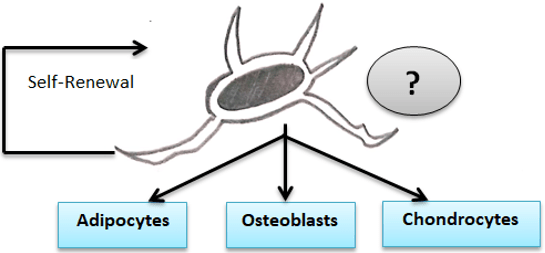This set of Tissue Engineering Questions & Answers for Exams focuses on “Mesenchymal Stem Cells”.
1. Mesenchymal stem cells are multipotent stromal cells that can differentiate into a variety of cell types.
a) Mesodermal cells
b) Ectodermal cells
c) Endodermal cells
d) Mesenchymal stem cells
View Answer
Explanation: Mesenchymal stem cells are multipotent stromal cells that can separate into an assortment of cell types, including osteoblasts (bone cells), chondrocytes (ligament cells), myocytes (muscle cells) and adipocytes (fat cells which offer ascent to marrow fat tissue).
2. Mesenchyme is derived from ___________
a) mesoderm
b) adherent cells
c) ectoderm
d) endoderm
View Answer
Explanation: Mesenchyme is the embryonic connective tissue that is gotten from the mesoderm and that separates into hematopoietic and connective tissue, though MSCs don’t separate into hematopoietic cells.
3. __________ are connective tissue cells that form the supportive structure in which the functional cells of the tissue reside.
a) Stromal cells
b) Ectodermal cells
c) Endodermal cells
d) Mesenchymal stem cells
View Answer
Explanation: Mesenchyme is the embryonic connective tissue that is gotten from the mesoderm and that separates into hematopoietic and connective tissue, though MSCs don’t separate into hematopoietic cells.
4. The mesenchymal cells do not have the capacity to reconstitute an entire organ.
a) TRUE
b) FALSE
View Answer
Explanation: The term ‘Mesenchymal undeveloped cells’ envelops multipotent cells gotten from other non-marrow tissues, for example, placenta, umbilical rope blood, fat tissue, grown-up muscle, corneal stroma or the dental mash of deciduous infant teeth. The cells don’t have the ability to reconstitute a whole organ.
5. What type of cell has been represented in the given diagram show?

a) Stromal cells
b) Ectodermal cells
c) Endodermal cells
d) Mesenchymal stem cells
View Answer
Explanation: Mesenchymal stem cells are described morphologically by a little cell body with a couple of cell forms that are long and slender. The cell body contains an enormous, round core with an unmistakable nucleolus, which is encompassed by finely scattered chromatin particles, giving the core a reasonable appearance.
6. The developing tooth bud of the mandibular third molar is a rich source of Mesenchymal Stem Cells.
a) TRUE
b) FALSE
View Answer
Explanation: The developing tooth bud of the mandibular third molar is a rich wellspring of MSCs. While they are portrayed as multipotent, it is conceivable that they are pluripotent. They in the long-run structure lacquer, dentin, veins, dental mash, and sensory tissues. These undeveloped cells are equipped for creating hepatocytes.
7. The youngest and most primitive MSCs may be obtained from umbilical cord tissue.
a) TRUE
b) FALSE
View Answer
Explanation: The youngest and most crude MSCs might be gotten from umbilical string tissue, to be specific Wharton’s jam and the umbilical rope blood. Notwithstanding, MSCs are found in a lot higher focus in the Wharton’s jam contrasted with rope blood, which is a rich wellspring of hematopoietic undeveloped cells.
8. Stem cells are present in amniotic fluid.
a) TRUE
b) FALSE
View Answer
Explanation: Stem cells are available in amniotic liquid. Upwards of 1 of every 100 cells gathered during amniocentesis are pluripotent mesenchymal foundational microorganisms.
9. _________________ is the most frequently utilized source of Mesenchymal stem cells.
a) Adrenal glands
b) Bone Marrow
c) Brain
d) Kidney
View Answer
Explanation: Bone marrow was the first wellspring of MSCs, and still is the most as often as possible used. These bone marrow immature microorganisms don’t add to the arrangement of platelets thus don’t express the hematopoietic undifferentiated cell marker CD34. They are here and there alluded to as bone marrow stromal undeveloped cells.
10. MSCs possess antipyretic properties.
a) TRUE
b) FALSE
View Answer
Explanation: MSCs have antimicrobial properties. MSCs can create antimicrobial peptides (AMPs). These incorporate human cathelicidin LL-37, β-defensins, lipocalin 2 and hepcidin. MSCs adequately decline the number of settlements of both gram-negative and gram-positive microbes by the generation of these AMPs. What’s more, a similar antimicrobial impact of the chemical IDO created by MSCs was found.
Sanfoundry Global Education & Learning Series – Tissue Engineering.
To practice all exam questions on Tissue Engineering, here is complete set of 1000+ Multiple Choice Questions and Answers.
If you find a mistake in question / option / answer, kindly take a screenshot and email to [email protected]
- Practice Biotechnology MCQs
- Check Biotechnology Books
- Apply for Biotechnology Internship
- Check Tissue Engineering Books
